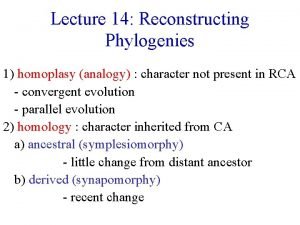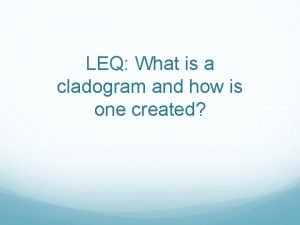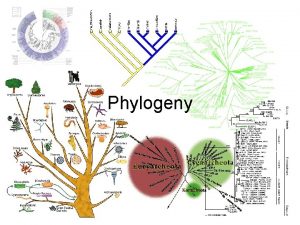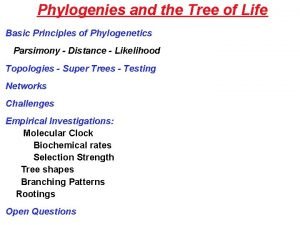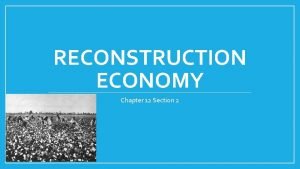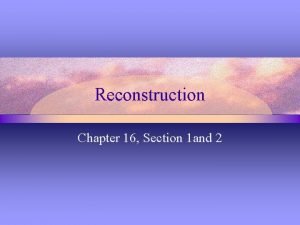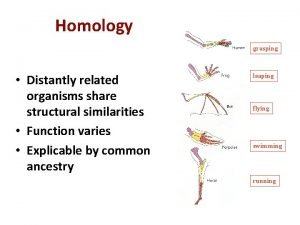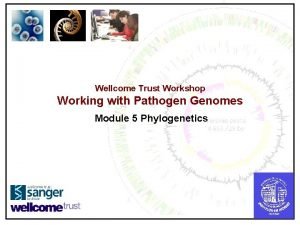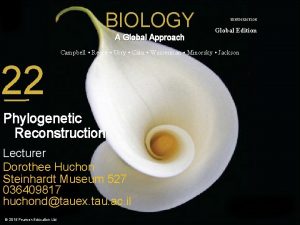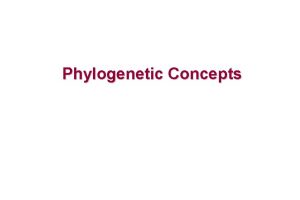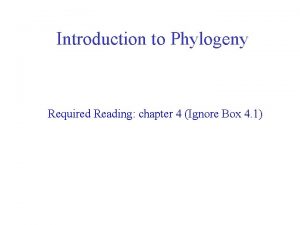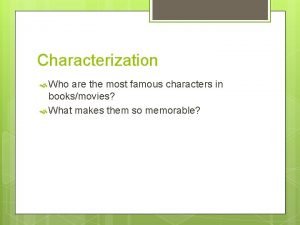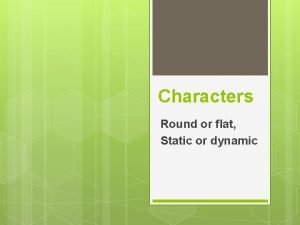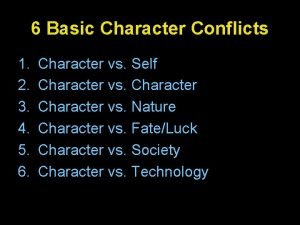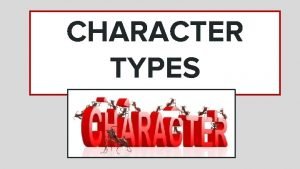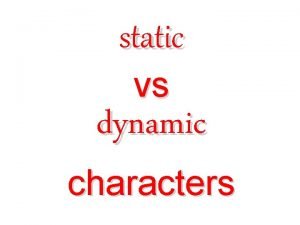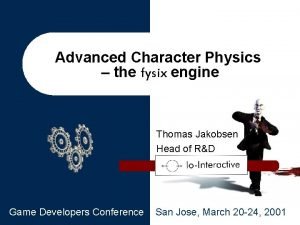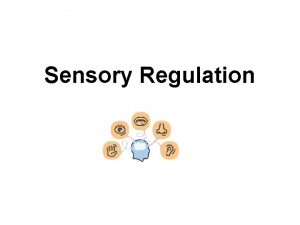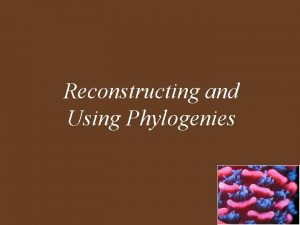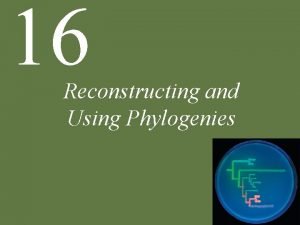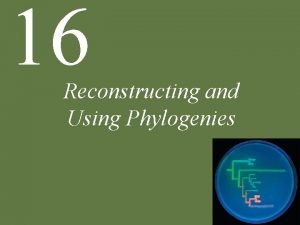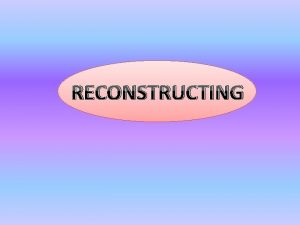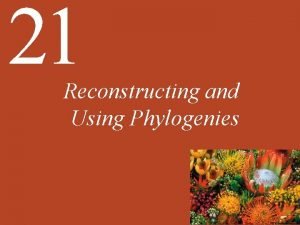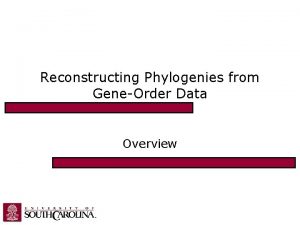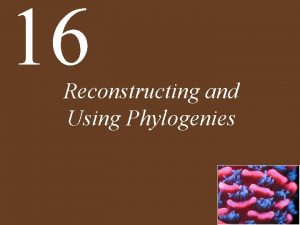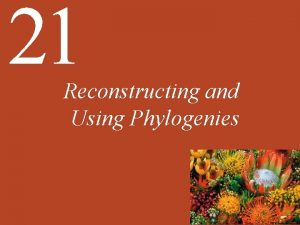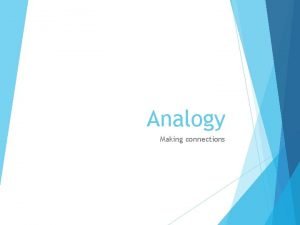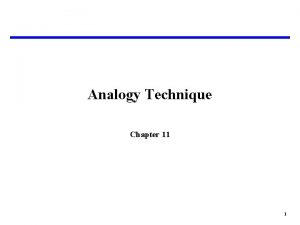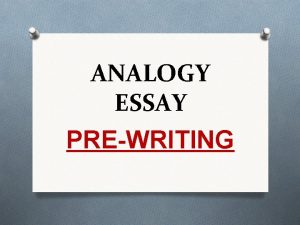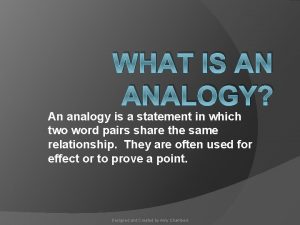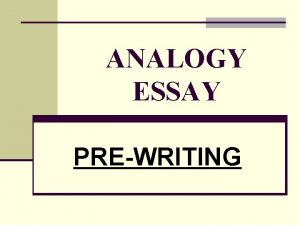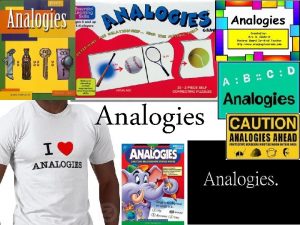Lecture 14 Reconstructing Phylogenies 1 homoplasy analogy character



















- Slides: 19

Lecture 14: Reconstructing Phylogenies 1) homoplasy (analogy) : character not present in RCA - convergent evolution - parallel evolution 2) homology : character inherited from CA a) ancestral (symplesiomorphy) - little change from distant ancestor b) derived (synapomorphy) - recent change

Homology vs. Analogy 1. Same fundamental structure humerus 2. Same relationship radius to surrounding ulna characters carpals phalanges 3. Similarities in embryology

Embryology Haeckel’s (1886) biogenetic “law” : • “ontogeny recapitulates phylogeny” • each embryonic stage = adult stage of ancestor WRONG! Von Baer’s (1828) law: • among related spp. , early stages are more similar than later stages • examination of early dev’t can reveal close relationships

Successive stages of vertebrate embryos: Examples fish • Cattle: metacarpals start off separate; fuse chicken during development • Anteaters: teeth present early in development; pig resorbed human

Von Baer’s Law • Sometimes useful to distinguish b/w ancestral & derived traits, not always: • e. g. fused cannon bone – derived toothlessness in Edentates – derived But, early stages may be special adaptations - “beak” of tadpole - milk teeth of bats - cotyledons in plants

• terminal stages of ancestor’s ontogeny may be lost e. g. paedomorphosis: (retention of juvenile characters in adult) - in salamanders is derived, not ancestral

Reconstruction continues… 1. distinguish homologies from analogies 2. distinguish ancestral homologies from derived homologies - need to determine polarity of change (ancestral → recent)

Strategies to Distinguish b/w Ancestral & Derived 1) morphocline or transformation series: e. g. chromosome inversions in Drosophila ABCDEFG ↔ AEDCBFG ↔ AEDFBCG - can infer sequence, but which is ancestral? a ↔ b

Outgroup Analysis • outgroup = taxon that diverged from a group before they diverged from each other • principle of parsimony: fewest changes • consider: 3 spp + outgroup sp. A B C D - 1 character, 2 states sp. 1 : b sp. 2 : b sp. 3 : a sp. O: a

2 hypotheses: 1 : a → b (a = ancestral; b derived) 2 : b → a (b = ancestral; a derived) 1 b 2 b 3 O a a 1 b vs. 2 3 b a O a b→a a→b b→a b a the character state present in the outgroup is assumed to be ancestral

Butterflies • brush-footed, monarchs → 2 reduced legs • swallowtails, sulphurs → 6 functional legs • which state is ancestral ? • Moths diverged from butterflies before they diverged from each other (moths = outgroup) • moths → 6 functional legs • most parsimonious : 6 functional legs = ancestral

5 Characters Character 1: • shared by A, B, C (synapomorphy) • separates them from outgroup

Character 2: • unique derived trait in taxon B • no info about relationships Character 3: • unique derived trait in taxon C • no info about relationships

Character 4: • synapomorphy • unites B & C Character 5: • unique derived trait in taxon A • no info

• Fused cannon bones in cattle; • Toothlessness in adult anteaters: • Derived traits b/c: unfused metacarpals & adult teeth are widespread in other mammals

Primitive characters • primitive condition in an ingroup is that which is found in outgroups • Common characters are not necessarily primitive! • Often true: owl monkeys are only nocturnal primate; nocturnal habit is derived However…

Primitive vs. Derived • Few vertebrates lack jaws, but jawlessness in lampreys is primitive, not derived • Distribution, not number of spp. with the trait, is important

Complete Fossil Record Can aid in analysis e. g. Progressive reduction in # of digits in horses • one-toed condition is derived • same info from outgroup analysis : rhinos & tapirs • But…

Litopterna • Extinct horse-like mammals: 3 – toed observed later than 1 – toed • Outgroup analysis necessary • In fact, more detailed fossil record shows 3 – toed both before & after 1 – toed
 Analogy of char
Analogy of char Lancelet cladogram
Lancelet cladogram Phylogenetic tree vocabulary
Phylogenetic tree vocabulary Phylogenies
Phylogenies Carpetbaggers and scalawags venn diagram
Carpetbaggers and scalawags venn diagram Chapter 12 section 2 reconstructing society
Chapter 12 section 2 reconstructing society Similarities
Similarities Homology vs homoplasy
Homology vs homoplasy Homoplasy
Homoplasy Plesiomorphic vs apomorphic
Plesiomorphic vs apomorphic Deer family tree
Deer family tree Homoplasy
Homoplasy 01:640:244 lecture notes - lecture 15: plat, idah, farad
01:640:244 lecture notes - lecture 15: plat, idah, farad Famous round characters
Famous round characters Flat character vs round character
Flat character vs round character Example of character vs character conflict
Example of character vs character conflict Types of minor characters
Types of minor characters Round flat static and dynamic characters
Round flat static and dynamic characters Fysix
Fysix Sensory cup analogy
Sensory cup analogy
